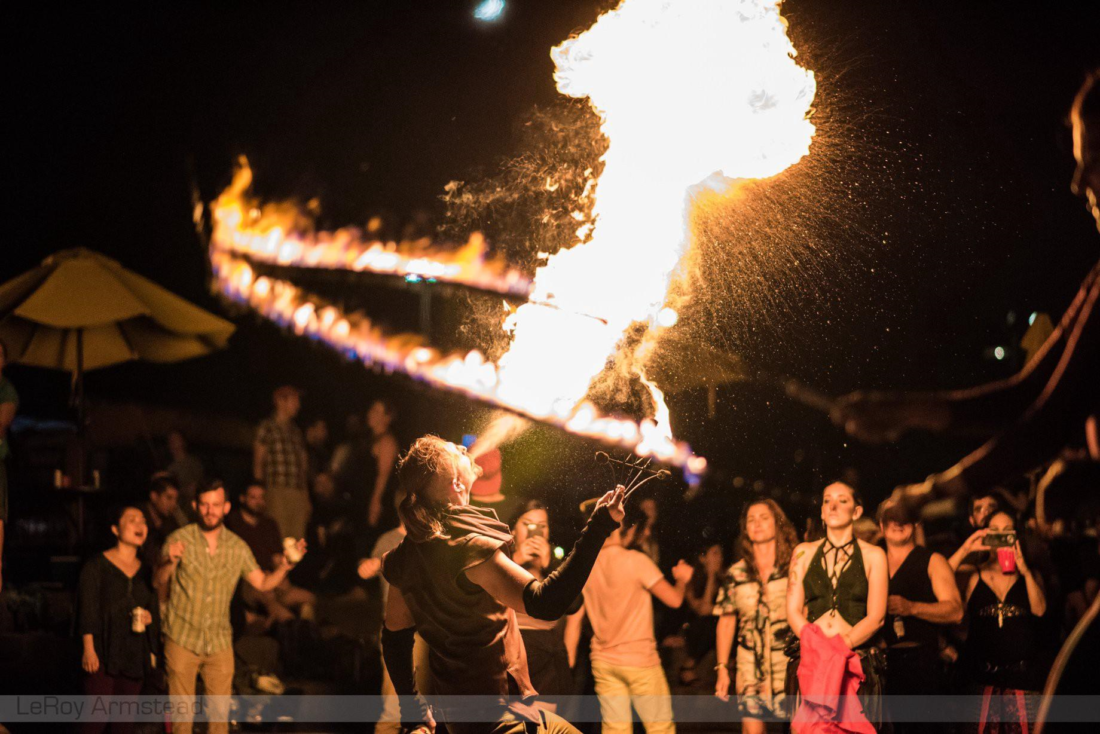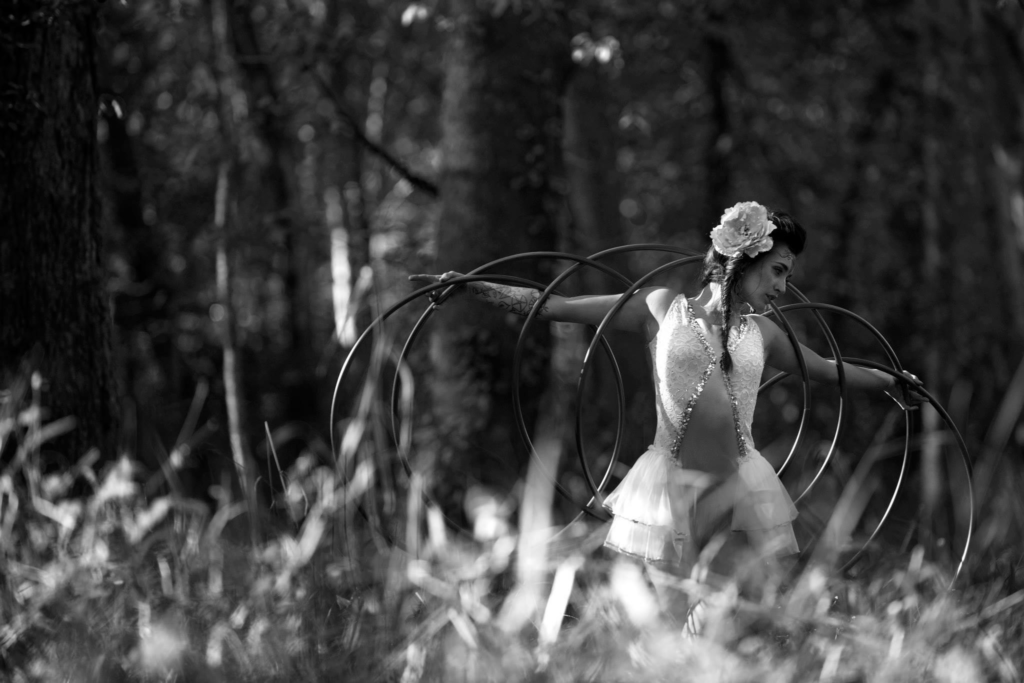By Thalia Patrinos (Tippy)
I can distinctly remember a specific moment where I “found my flow.” I was performing at Psycho Stompers outside of Cape Town, South Africa — my first psychedelic trance party. It may have been the fact that I had stayed up all night. It may have been the fact that the music was overpowering me. Or it may have been that all of my friends were dancing all around me, encouraging me to join…but all of a sudden, I was lost in that moment. I felt nothing else but my hoop and that music. You could say, quite literally, I was in a trance — lost completely to the elation of that experience. When I think back to that moment, it is still happening. An infinite loop of joy, caught in space and time.
“Flow arts,” as defined by the Flow Arts Institute, describe the intersection of movement-based disciplines such as dance, juggling, fire spinning, and prop manipulation. Flow arts are growing all the time — constantly cross-pollinating and mixing genes and creating flow arts diversity. You might see a flow artist juggling, hula hooping, slacklining, or balancing a sword on her head…or perhaps, all of these at the same time.
The moment I described having in South Africa is what you might call achieving the “flow state,” and according to many, it is, in fact, an achievement. In their recent book, Stealing Fire, Steven Kotler and Jamie Wheal describe the “flow state” as a performance-enhancing turbo-boost — one heavily sought after by multi-billion dollar companies and even military branches in order to drive innovation.
Michael Pollan, author of Botany of Desire, explains the flow state as “a kind of transcendence — a mental state of complete and utter absorption well known to artists, athletes, gamblers, musicians, dancers, soldiers in battle, mystics, meditators, and the devout during prayer.” The flow state heightens your experience, focuses you on the present moment, and abandons all regret and worry. “It is a state that depends for its effect on losing oneself in the moment, usually training a powerful, depthless concentration on One Big Thing.”
In this article, I explore the relationship between the “flow state” and “flow arts.” Will getting into hula hooping grant you an all-access pass to a heightened state? Will learning how to juggle increase your ability to focus? Will getting into “flow” get you to “flow”?
The question is…if you pick up some poi, will it improve your life?
In the zone
The expression “find your flow” can mean something very different to different people. To me, the flow state is almost always conjured by dancing, but it can also be summoned while on a painting binge, or even now, while I am writing this article.
“A Buddhist monk experiencing satori while meditating in a cave, or a nuclear physicist having a breakthrough insight in the lab, or a fire spinner at Burning Man, look like different experiences from the outside, but they feel similar from the inside,” says Jason Silva, Emmy-nominated TV personality and storyteller. “It’s a shared commonality, a bond linking all of us together. The ecstatic is a language without words that we all speak.”
Sometimes, people try to hack into the flow state by taking psychedelics or stimulants. Creators of all kinds — writers, filmmakers, even flow artists — might take a drug to find some inspiration (or “spin-spiration.”) But you don’t have to pop a pill to feel transcendence.
“Using drugs is not the only way to achieve altered states of consciousness,” argues Pollan in Botany of Desire. “Activities as different as meditation, fasting, exercise, amusement park rides, horror movies, extreme sports, sensory or sleep deprivation, chanting, music, eating spicy foods, and taking extreme risks of all kinds have the power to change the texture of our mental experience.”
Kotler argues that whether your “in-the-zone” moment is cultivated by a meditation retreat or a bungee jump, these seemingly unrelated phenomena share remarkable neurobiological similarities.
While experiencing altered states of consciousness, there are distinctive changes happening to our brains. Brainwaves slow down from the usual high-frequency beta range to “dreamy alpha and deeper theta.” Instead of producing stress chemicals like cortisol, the brain produces chemicals such as dopamine, endorphins, anandamide, serotonin, and oxytocin — chemicals that induce pleasure.
Ask different people what “flow” means to them, and they might all give you a different answer. But — at least neurobiologically — we are all sharing the same feeling of heightened experience.
One such person is Jonathan Livingston Baxter — a hooping legend within the flow community. He has been hula hooping since 2001 and has been traveling and teaching workshops since 2005. He, with several other people during this time period, redefined the genre. The circular, plastic wheel we call a hula hoop has reinvented itself several times since its introduction in the 1950s — it’s no longer just about keeping it around your waist. Baxter contributed to the beginning of a “new wave” of hooping, a wave that intentionally combined hula hoops with dance. You put these two together, and you have hoopdance — a style of flow.
Baxter hosts a FutureHero podcast where he facilitates relaxing meditations as well as conversations about flow. This is his take on flow: “Flow is actually a feeling for me of confidence…one of the ways I sort of define confidence is when you are firmly in your element. When I am in flow, I am firmly in the element of my hoop dance. I’m not looking for validation.”
Brecken Rivara, another well-known hoop artist in the flow community, has another take: “It’s kind of a state of home base feeling in a way. I’m a highly expressive emotional body tech hooper. It’s like a track. How do I explain it? I go toward a feeling. There are extensions that can come from it.”
Another notable voice is Noel Yee, popular for his expertise in flow arts ranging from contact staff to poi to buugeng. He is disciplined in his practice and well-known as a prominent instructor and performer.
Yee also hosts a podcast, entitled Sticks Out. In one episode, he interviews Elizabeth Knights, an accomplished performer and tech poi spinner. “The thing I experience closest to flow is when I am choreographing,” she says. “That’s when I experience the most joy and connection to the music. I want to be able to combine the vocabulary I have in an effortless manner.”
Deliberate Practice
So how do we build the vocabulary necessary to “combine in an effortless manner”? The answer is deliberate practice.
The case for deliberate practice can be made for all careers, all hobbies, all people — not just flow artists. Cal Newport, author of Deep Work, argues that the key to succeed in the growing economy will be in our ability to perform “deep work” — that is, work that is focused, productive, and free of distractions. When was the last time you solidly worked on building a skill, for several hours at a time — without checking your phone once? Newport argues that even momentary distractions, like reading an email, can fill your brain with “residue” that makes it difficult to fully commit to the task at hand.
Let’s say you are a poi spinner learning how to perform a certain trick, or a computer programmer teaching herself to code — what is happening in your brain while you are focusing on a specific skill? Neurologically, you are isolating a specific circuit in your brain to fire again and again. This repetitive action builds layers of myelin around the neurons in the circuits, cementing the skill — literally hard-wiring it. When you are distracted instead, you are firing circuits all over the place, and the skill you want to strengthen doesn’t get the repetitive, isolated myelination it needs.
Flow artists understand that although flow feels natural, blissful, effortless — at the foundation of every flow session is months, even years of hard work. In order to feel at ease with a prop, a flow artist needs to build a “vocabulary” of movements to pull from during a state of flow. This means that they will spend hours deliberately practicing skills, in order to isolate that group of neurons to be strengthened.
I’m not saying that all flow artists are capable of completely focused, distraction-free work — but many of us are at least familiar with the concept that if you want to learn the move, you have to put into the work. And hopefully, the honed ability to focus and establish goals can bleed into other parts of our lives, too.
Twyla Tharp, world-renowned dancer, choreographer, and author, swears by the method of deliberate practice. In her book, The Creative Habit, she states: “It’s vital to establish some rituals — automatic but decisive patterns of behavior — at the beginning of the creative process, when you are most at peril of turning back, chickening out, giving up, or going the wrong way.” Building a routine of deliberate practice keeps you from making any excuses — there’s no longer any choice in the matter. You’re practicing today, because you’re practicing everyday, and that’s just how it is.
“Moving around in the traditional flower style with poi is effortless,” Ben Drexler, flow arts instructor and performer, told Baxter on the FutureHero podcast. “It feels very much like it’s just an extension of my body. It doesn’t require thought any more to engage with it.” But the ability for poi to be “effortless,” is not something that happened overnight for Drexler — this is only the result of many years of engaged focus.
Drexler is a vocal advocate for systematic goal setting, as well as establishing regular and consistent time on your calendar to work on your craft. It’s no wonder that he has been able to achieve so much — not only an arsenal of skills related to poi and double staff, but an encyclopedic database of tutorials for his massive following of students.
Nick Woosley, another popular poi spinner, also shared with Yee his secret to his success: “Up until 2010, the first ten years of doing poi I really maintained a steady practice. I was doing it a lot. What was motivating me was a vision of how I wanted to spin. Around 2010, I could spin that way. I could flow in a way that was a vision.”
Even Mihaly Csikszentmihalyi, one of the world’s best known psychologists, believed that the crux of flow is in difficult work: “The best moments usually occur when a person’s body or mind is stretched to its limits in a voluntary effort to accomplish something difficult and worthwhile.”
Altered States, Altered Traits
Okay, so let’s say you put all of this time and energy into your chosen flow art — what then? Will it have any positive effect on your life?
“Every hooper/flow person says the same thing — it did save my life,” says Baxter in his interview for Yee. “I don’t know if it saved me from non-life — meaning death — but it definitely saved me from a boring life.”
Establishing regular access to the flow state has been shown to have long-lasting benefits — it helps us cultivate the exceptional parts of ourselves. It’s the turbo-button for personal development.
Kotler and Wheal cite numerous studies on the flow state, but I’ll just leave you with their summary: “Taken together, all this work — from the NDE studies to the cancer and trauma research to the flow and meditation programs — demonstrates that even brief moments spent outside ourselves produce positive impact, regardless of the mechanisms used to get there.”
Flow arts are simply a tool you can use for building that gateway into non-ordinary states.
Baxter believes that people should teach and perform flow arts based on what they love about it. For him, the love comes from the improvisational movement, the unpredictable moments — the freedom from mental blockage.
Baxter’s workshops do not take the usual form of “here’s a trick, now you try.” His strategy for helping people reach the flow state is a combination of story telling and movement exercises. Instead of instructing his class to take a series of steps to learn a certain move, he will tell his students to “move like seaweed,” or “pretend like you’re flying.”
The goal is to help people who experience dance shyness and reluctance to move. By playing around with stories and narratives, he is able to encourage his students to assume a persona/character confident enough to explore movement.
“What a story does — and an invitation to join the story — it changes the operating system. You get out of their current operating system and into the operating system of hero. Of an archetype. Of a samurai. Of a badass hoop goddess. You’re no longer trapped.”
Achieving the flow state, especially in regular intervals, can change your operating system. It helps us perceive and process more fully. When I am really flowing, I am performing moves I never knew I had. I am more seamlessly connecting pieces of my vocabulary. I am fully immersed, undistracted — and enjoying every second of it.
“The effect of altered consciousness is to admit a whole lot more information into a much smaller increment of experience,” says Pollan. And that’s how Kotler and Wheal see it too — as a type of information technology. “Big Data for our minds.”
We are often focused on so many different things at once, we don’t realize how fractured our brainpower is. We’re walking to work while texting our friends. We’re going shopping while trying to remember everything we need to buy. We’re listening to music while driving a car and putting on makeup. Now imagine if all your mental attention was focused on only one thing. And in addition, you’re having the time of your life.
“The flow world is so good for us,” says Baxter. “Flow life is so good. It’s community-based. It’s so good for our reaction time, and for keeping us sharp. It’s so much more than getting into festivals for free. Because every once in a while, you realize, I just did something badass. It’s very rewarding.”
You are learning skills — not only in your chosen art form — but also skills in mindfulness. Concentration. You are learning how to learn.
“By bridging the gap between peak states and personal growth, these discoveries validate ecstasis as a tool not only for self-discovery, but also for self-development,” say Kotler and Wheal. “In short, altered states can lead to altered traits.”*
Conclusion
So to answer my first question — will becoming a flow artist improve your life? Will picking up some poi amplify your connection to the world — to yourself?
I guess the true answer is — it depends. I won’t tell you that the first time you pick up a pair of poi, the neurons will start exploding in your brain and you’ll feel connected to everything in the world at once. In fact, chances are, you’ll probably hit yourself in the face a couple times. It might take a lot of energy and time committed to deliberate practice, but eventually, you will feel it. It’s a feeling all dedicated flow artists know and love. But if poi isn’t your cup of tea, and neither are hula hoops or juggling balls — the flow state is achievable through just about any focused exercise.
So — I suppose the flow arts are what you make of it.
But it certainly couldn’t hurt to try.
*I’m simply listing the mental benefits — I’m not even touching the physical benefits here. Another thing to mention is how beneficial it is simply to join the flow arts community.
I have traveled a lot in the past few years. Over the past five years, I have lived in eight different cities. Two of which in an entirely different country. But no matter where I have gone, I have always been able to find my people — my “flowmies.” It hasn’t mattered if I have been in the backyards of Brooklyn or the dust storms of Afrikaburn…if I have a hoop, I have a friend.
This article was written by Thalia Patrinos (Tippy)
Works Cited
Csikszentmihalyi, Mihaly. Flow: The Psychology of Optimal Experience. New York: Harper & Row Publishers, 1990.
Kotler, Steven & Wheal, Jamie. Stealing Fire. New York: HarperCollins, 2017.
Newport, Cal. Deep Work: Rules for Focused Success in a Distracted World.New York: Grand Central Publishing, 2016.
Pollan, Michael. The Botany of Desire: A Plant’s-Eye View of the World.Random House, 2001.
Tharp, Thwyla. The Creative Habit: Learn it and Use it for Life. New York: Simon & Schuster Paperbacks, 2003.










